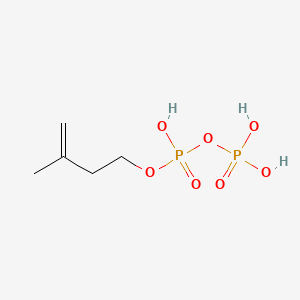| MeSH term | MeSH ID | Detail |
|---|---|---|
| Melanoma | D008545 | 69 associated lipids |
Isopentenyl pyrophosphate
Isopentenyl pyrophosphate is a lipid of Prenol Lipids (PR) class. Isopentenyl pyrophosphate is associated with abnormalities such as Tuberculosis, NAVAJO NEUROHEPATOPATHY and Cryptosporidiosis. The involved functions are known as Signal, Anabolism, T-Cell Activation, T-Cell Proliferation and isoprenoid biosynthetic process. Isopentenyl pyrophosphate often locates in Protoplasm, Host Cell, soluble, Plastids and Cell surface. The associated genes with Isopentenyl pyrophosphate are oxytocin, 1-desamino-(O-Et-Tyr)(2)-, HLA-E gene, RAP1A gene, Gene Family and Orthologous Gene. The related lipids are Steroids, Sterols and isopentenol.
Cross Reference
Introduction
To understand associated biological information of Isopentenyl pyrophosphate, we collected biological information of abnormalities, associated pathways, cellular/molecular locations, biological functions, related genes/proteins, lipids and common seen animal/experimental models with organized paragraphs from literatures.
What diseases are associated with Isopentenyl pyrophosphate?
Isopentenyl pyrophosphate is suspected in Tuberculosis, NAVAJO NEUROHEPATOPATHY, Cryptosporidiosis and other diseases in descending order of the highest number of associated sentences.
Related references are mostly published in these journals:
| Disease | Cross reference | Weighted score | Related literature |
|---|
Possible diseases from mapped MeSH terms on references
We collected disease MeSH terms mapped to the references associated with Isopentenyl pyrophosphate
PubChem Associated disorders and diseases
What pathways are associated with Isopentenyl pyrophosphate
Lipid pathways are not clear in current pathway databases. We organized associated pathways with Isopentenyl pyrophosphate through full-text articles, including metabolic pathways or pathways of biological mechanisms.
Related references are published most in these journals:
| Pathway name | Related literatures |
|---|
PubChem Biomolecular Interactions and Pathways
Link to PubChem Biomolecular Interactions and PathwaysWhat cellular locations are associated with Isopentenyl pyrophosphate?
Visualization in cellular structure
Associated locations are in red color. Not associated locations are in black.
Related references are published most in these journals:
| Location | Cross reference | Weighted score | Related literatures |
|---|
What functions are associated with Isopentenyl pyrophosphate?
Related references are published most in these journals:
| Function | Cross reference | Weighted score | Related literatures |
|---|
What lipids are associated with Isopentenyl pyrophosphate?
Related references are published most in these journals:
| Lipid concept | Cross reference | Weighted score | Related literatures |
|---|
What genes are associated with Isopentenyl pyrophosphate?
Related references are published most in these journals:
| Gene | Cross reference | Weighted score | Related literatures |
|---|
What common seen animal models are associated with Isopentenyl pyrophosphate?
There are no associated biomedical information in the current reference collection.
NCBI Entrez Crosslinks
All references with Isopentenyl pyrophosphate
Download all related citations| Authors | Title | Published | Journal | PubMed Link |
|---|---|---|---|---|
| Radakovits R et al. | Draft genome sequence and genetic transformation of the oleaginous alga Nannochloropis gaditana. | 2012 | Nat Commun | pmid:22353717 |
| Al-Bazi MM et al. | Reduced coenzyme Q(10) in female smokers and its association with lipid profile in a young healthy adult population. | 2011 | Arch Med Sci | pmid:22328876 |
| Leblond JD et al. | Sterol composition and biosynthetic genes of the recently discovered photosynthetic alveolate, Chromera velia (chromerida), a close relative of apicomplexans. | 2012 May-Jun | J. Eukaryot. Microbiol. | pmid:22313428 |
| Ma Y et al. | Genome-wide identification and characterization of novel genes involved in terpenoid biosynthesis in Salvia miltiorrhiza. | 2012 | J. Exp. Bot. | pmid:22291132 |
| pmid:22281742 | ||||
| Wen W and Yu R | Artemisinin biosynthesis and its regulatory enzymes: Progress and perspective. | 2011 | Pharmacogn Rev | pmid:22279377 |
| Aros D et al. | Volatile emissions of scented Alstroemeria genotypes are dominated by terpenes, and a myrcene synthase gene is highly expressed in scented Alstroemeria flowers. | 2012 | J. Exp. Bot. | pmid:22268153 |
| Nagel R et al. | Nonradioactive assay for detecting isoprenyl diphosphate synthase activity in crude plant extracts using liquid chromatography coupled with tandem mass spectrometry. | 2012 | Anal. Biochem. | pmid:22266300 |
| Angaman DM et al. | Precursor uptake assays and metabolic analyses in isolated tomato fruit chromoplasts. | 2012 | Plant Methods | pmid:22243738 |
| Post J et al. | Laticifer-specific cis-prenyltransferase silencing affects the rubber, triterpene, and inulin content of Taraxacum brevicorniculatum. | 2012 | Plant Physiol. | pmid:22238421 |
| Holte D et al. | An approach to mimicking the sesquiterpene cyclase phase by nickel-promoted diene/alkyne cooligomerization. | 2012 | J. Org. Chem. | pmid:22229741 |
| Baikar S and Malpathak N | Secondary metabolites as DNA topoisomerase inhibitors: A new era towards designing of anticancer drugs. | 2010 | Pharmacogn Rev | pmid:22228937 |
| Odom AR | Five questions about non-mevalonate isoprenoid biosynthesis. | 2011 | PLoS Pathog. | pmid:22216001 |
| Vivas Y et al. | Early peroxisome proliferator-activated receptor gamma regulated genes involved in expansion of pancreatic beta cell mass. | 2011 | BMC Med Genomics | pmid:22208362 |
| Rauthan M and Pilon M | The mevalonate pathway in C. elegans. | 2011 | Lipids Health Dis | pmid:22204706 |
| Wang L et al. | Genome characterization of the oleaginous fungus Mortierella alpina. | 2011 | PLoS ONE | pmid:22174787 |
| pmid:22166808 | ||||
| Green SA et al. | Identification, functional characterization, and regulation of the enzyme responsible for floral (E)-nerolidol biosynthesis in kiwifruit (Actinidia chinensis). | 2012 | J. Exp. Bot. | pmid:22162874 |
| Chow KS et al. | Metabolic routes affecting rubber biosynthesis in Hevea brasiliensis latex. | 2012 | J. Exp. Bot. | pmid:22162870 |
| Pan J et al. | ATP synthase ecto-α-subunit: a novel therapeutic target for breast cancer. | 2011 | J Transl Med | pmid:22152132 |
